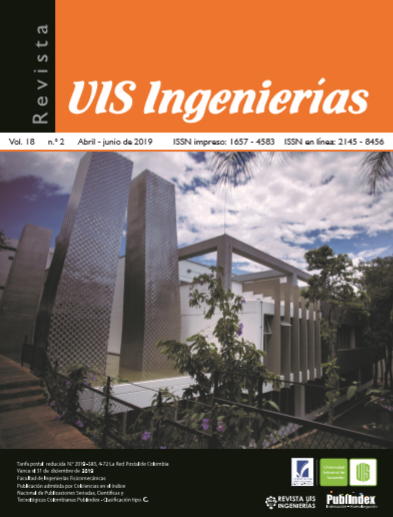Published 2019-02-07
Keywords
- fluid mechanics,
- shape evolution,
- wing profile
How to Cite
Abstract
In the domain of fluid dynamics, the problem of shape optimization is relevant because is essential to increase lift and reduce drag forces on a body immersed in a fluid. The current state of the art in this aspect consists of two variants: (1) evolution from an initial guess, using optimization to achieve a very specific effect, (2) creation and genetic breeding of random individuals. These approaches achieve optimal shapes and evidence of response under parameter variation. Their disadvantages are the need of an approximated solution and / or the trial - and - error generation of individuals. In response to this situation, this manuscript presents a method which uses Fluid Mechanics indicators (e.g. streamline curvature, pressure difference, zero velocity neighborhoods) to directly drive the evolution of the individual (in this case a wing profile). This pragmatic strategy mimics what an artisan (knowledgeable in a specific technical domain) effects to improve the shape. Our approach is not general, and it is not fully automated. However, it shows to efficiently reach wing profiles with the desired performance. Our approach shows the advantage of application domain - specific rules to drive the optimization, in contrast with generic administration of the evolution.
Downloads
References
P. Nørtoft and J. Gravesen, “Isogeometric shape optimization in fluid mechanics,” Structural and Multidisciplinary Optimization, vol. 48, no. 5, pp. 909–925, 2013.
E. Immonen, “2d shape optimization under proximity constraints by cfd and response surface methodology,” Applied Mathematical Modelling, vol. 41, pp. 508–529, 2017.
K. Zhao, Z. Gao, J. Huang, and Q. Li, “Aerodynamic optimization of rotor airfoil based on multi-layer hierarchical constraint method,” Chinese Journal of Aeronautics, vol. 29, no. 6, pp. 1541–1552, 2016.
R. Mukesh, K. Lingadurai, and U. Selvakumar, “Airfoil shape optimization using non- traditional optimization technique and its validation,” Journal of King Saud University - Engineering Sciences, vol. 26, no. 2, pp. 191–197, 2014.
E. Gillebaart and R. De Breuker, “Low-fidelity 2d isogeometric aeroelastic analysis and optimization method with application to a morphing airfoil,” Computer Methods in Applied Mechanics and Engineering, vol. 305, pp. 512–536, 2016.
T. Zhao, Y. Zhang, H. Chen, Y. Chen, and M. Zhang, “Supercritical wing design based on airfoil optimization and 2.75 d transformation,” Aerospace Science and Technology, vol. 56, pp. 168–182, 2016.
Andres Espinosa-Moreno and Carlos Duque-Daza, “Efecto del radio de redondeo de la carina en el desarrollo del flujo a traves de un modelo sintetico de vias respiratorias,” Rev. UIS Ing., vol.17, no. 2, pp. 215-222, 2018.
S. Askari and M. Shojaeefard, “Shape optimization of the airfoil comprising a cross flow fan,” Aircraft Engineering and Aerospace Technology, vol. 81, no. 5, pp. 407–415, 2009.
L. Patruno, M. Ricci, S. de Miranda, and F. Ubertini, “Numerical simulation of a 5: 1 rectangular cylinder at non-null angles of attack,” Journal of Wind Engineering and Industrial Aerodynamics, vol. 151, pp. 146–157, 2016.
C. Park and S. Lee, “Effects of free-end corner shape on flow structure around a finite cylinder,” Journal of Fluids and Structures, vol. 19, no. 2, pp. 141–158, 2004.
S. Jain, V. D. Bhatt, and S. Mittal, “Shape optimization of corrugated airfoils,” Computational Mechanics, vol. 56, no. 6, pp. 917–930, 2015.
S.-H. Seo and C.-H. Hong, “Performance improvement of airfoils for wind blade with the groove,” International Journal of Green Energy, vol. 13, no. 1, pp. 34–39, 2016.
F. Pérez-Arribas and I. Castañeda-Sabadell, “Automatic modelling of airfoil data points,” Aerospace Science and Technology, vol. 55, pp. 449–457, 2016.
Kevin Molina, Daniel Ortega, Manuel Martinez, William Pinto-Hernandez, and Octavio Andres Gonzalez-Estrada “Modelado de la interaccion fluido estructura (fsi) para el diseno de una turbina eolica hawt”, Rev. UIS Ing., vol. 17, no. 2, pp. 269-282, 2018. doi: 10.18273/revuin.v17n2-2018023
D. SS, V. PMHW et al., “Design of fuselage shapes for natural laminar flow,” NASA Langley Technical Report Server, Tech. Rep., 1986.
Y. Ogawa and M. Kawahara, “Shape optimization of body located in incompressible viscous flow based on optimal control theory,” International Journal of Computational Fluid Dynamics, vol. 17, no. 4, pp. 243–251, 2003.
Y. A. C¸engel, J. M. Cimbala, V. C. Olguín, and S. F. Skarina, Mecánica de fluidos: fundamentos y aplicaciones. McGraw-Hill S˜ ao Paulo, 2006, vol. 1.
P. Manfredo, do Carmo. Differential geometry of curves and surfaces, 1st ed. Prentice Hall, 1976, chapter 1.
B. Mohammadi and O. Pironneau, “Shape optimization in fluid mechanics,” Annual Reviews of Fluid Mechanics, vol. 36, pp. 255–279, 2004.

